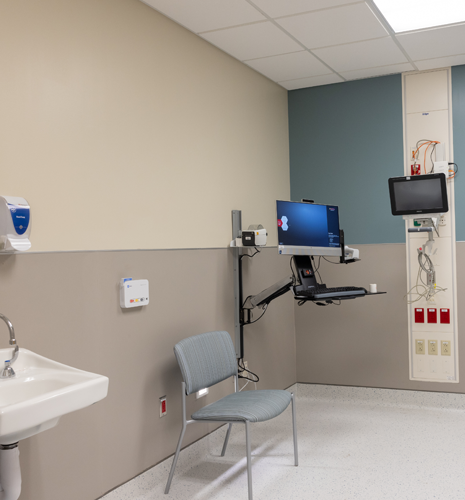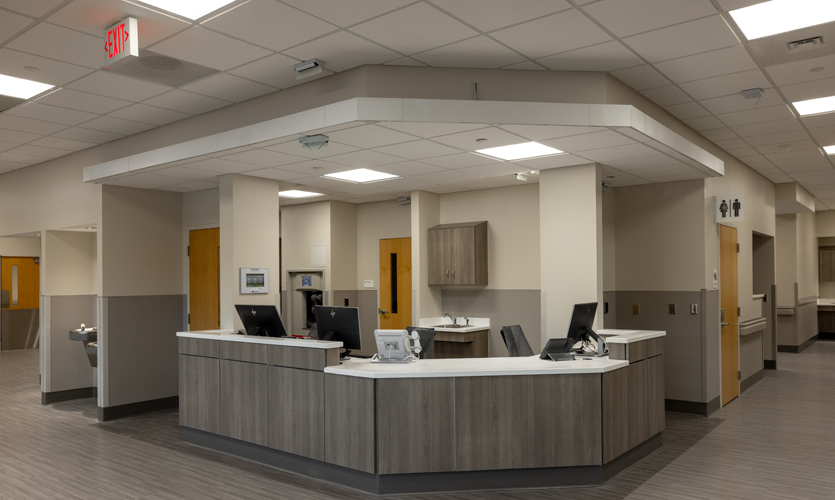Tuomey Emergency Department
Prisma Health

The SSOE Group architecture, interior, and engineering design teams worked closely with the Tuomey Hospital clinical and facilities staff to expand and renovate the emergency department in Sumter, South Carolina. The ED was originally constructed in the early 1990s. In addition to expanding the facility to accommodate a greater patient load, the existing space is modified to increase efficiency and reduce wait times. The project was designed and constructed in three phases, which allowed emergency services to remain fully operational throughout the construction process. Phase One included a 17,000 SF addition to establish a new walk-in entrance, security station, and patient / family waiting area.
A Rapid Medical Evaluation (RME) unit featuring six triage rooms, which provides immediate patient assessment. In addition, a 22-seat Results Lounge includes a comfortable space for patients and families to wait while diagnostic testing and lab work is being conducted. Patients requiring more acute care can be quickly transferred to one of the adjacent treatment rooms that encircle a central Team Center, where staff have visual observation of 18 new rooms. A new diagnostic imaging room within the ED provides convenience for all patients.
Phase Two includes 13,000 SF of renovations to enlarge existing treatment rooms, create a family waiting area, expansion of support services, and enhancements to staff amenities. Phase Three, to be completed in the future, is designed to enlarge all remaining original treatment spaces, and upgrade trauma bays, and the original nurse and physician work areas. In addition to the six RME Triage rooms, there are a total of 42 treatment rooms and bays.


Have a question regarding our services? Need assistance with an upcoming project? Send us an email. We look forward to hearing from you and will follow up soon.
© SSOE GROUP 1948-2025
Legal | Privacy Policy | CA Privacy Policy | Cookie Policy
Website designed and developed by
Raincastle Communications, Inc.

 VA Medical Center Interior Renovation
VA Medical Center Interior RenovationAutodesk Construction Cloud (ACC) is SSOE’s enterprise-wide project delivery platform. We partner with the Autodesk Product team and have research access. Use of the AI Assistant allows our design teams, owners, and general contractors the ability to query the project specifications for quality, answers, and more rapid responses to RFIs, submittals, or issues.
SSOE has developed a proof-of-concept to use an AI Agent to act as a Master Engineer and Architect trained in SSOE’s processes, best-known-methods, and trainings. Our data structure is being remodeled to enable better use of our proprietary knowledge to train the agent on the ‘SSOE way’.
SSOE is actively piloting AI Chat large language models (LLMs) or copilots that use Natural Language Processing (NLP) to streamline both design and development tasks, transforming how our teams interact with software and each other.
By integrating chat LLM engines into platforms like Revit, we’re enabling users to prompt complex actions using simple, conversational commands. In Revit, this means automating tasks such as modeling elements, cleaning up parameter data, managing annotations and dimensions, and organizing sheets—without writing scripts. These automations and quality prompts can be shared across project teams, accelerating workflows and reducing manual effort.
Similarly, our internal Software Development Community is leveraging GitHub Copilot to expedite coding tasks. Developers can generate and refine code using NLP prompts, tapping into GitHub’s extensive Repo to move faster from concept to implementation.
Together, these tools represent a shift from traditional, expert-driven scripting to intuitive, AI-assisted automation, unlocking new levels of efficiency and scalability across our projects.
We helped our client visualize and optimize façade design for occupant comfort—long before breaking ground through the use of the Autodesk Forma tool. It allows the designer to rapidly experiment with the building’s geometry and façade design to promote sustainability, prioritizing quality of spaces and comfort for end uses, especially in extreme climates (daylighting and microclimate analysis tools) at the project’s exact geographic location, using location-specific environmental data.
Discover how SSOE is using Autodesk Forma to improve sustainability outcomes for industrial projects: SSOE Group: Improving sustainability outcomes for industrial projects with Autodesk Forma.
SSOE is utilizing Microsoft Copilot Edge and M365 to significantly enhance work efficiency and accuracy across various departments. Copilot is accessible to all staff after training. Key areas of application include using it as a writing assistant, for idea generation, document summarization and generation, research assistant, excel assistant, programming code assistant, language translations, product comparison and data analysis. Use of Copilot has become part of the everyday life of SSOE employees who have identified key ways it can help them become more efficient with their daily tasks as well as more accurate in their deliverables.
Today, 100% of SSOE employees have taken the voluntary training and have access to Copilot Edge, achieving early our October 1, 2025 goal.
We found ourselves in need of a more robust tool to enhance resource forecasting and staff assignment capabilities. Instead of waiting for the perfect tool, we’re building it. SSOE’s in-house technology team has developed and piloted a tool that aims to forecast optimal staff mix and duration for new projects against existing workload to better understand capacity and manage resources efficiently. Additionally, the tool will allow teams to identify gaps to optimal staff mix.